Introduction
In the rapidly evolving landscape of 21st-century education, the role of the teacher has undergone significant transformation. Modern teachers are not merely conveyors of information; they are facilitators of learning, guides in the exploration of knowledge, and role models for lifelong learning habits. As the educational environment continues to change due to technological advancements, cultural shifts, and new pedagogical research, teachers must adapt to meet these challenges effectively. This adaptation is characterized by a set of habits and attitudes that distinguish modern educators from their predecessors. They embody qualities such as vulnerability, adaptability, and a commitment to continuous improvement, which are essential in fostering a dynamic and engaging learning environment (Darling-Hammond et al., 2020).
The profile of a modern teacher includes a broad spectrum of attributes that collectively enhance the educational experience for students. These educators see themselves as co-learners rather than mere dispensers of knowledge, allowing themselves to fail and learn alongside their students. They embrace change, step outside their comfort zones, and encourage their students to question everything, fostering critical thinking and curiosity. Moreover, modern teachers believe in the potential for growth in both themselves and their students, advocating for a growth mindset where effort and attitude are seen as key determinants of success (Dweck, 2006). By promoting peer learning and feeling secure in seeking help from colleagues, they build a supportive and collaborative educational community. This holistic approach not only improves academic outcomes but also prepares students to navigate and contribute to an ever-changing world.
In a rapidly changing educational landscape, modern teachers:
1. Choose to be vulnerable
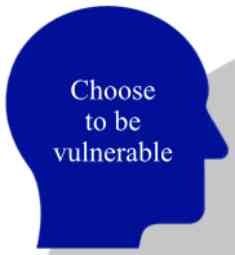
2 Corinthians 12:9 - "But he said to me, 'My grace is sufficient for you, for my power is made perfect in weakness.' Therefore I will boast all the more gladly about my weaknesses, so that Christ’s power may rest on me."
Modern teachers who choose to be vulnerable actively acknowledge and share their own limitations and uncertainties with their students. This openness can significantly impact the classroom environment, fostering a culture of trust and mutual respect. By admitting that they do not have all the answers, teachers model humility and a growth mindset, demonstrating that learning is a continuous journey rather than a finite destination. This practice encourages students to feel comfortable expressing their own doubts and questions without fear of judgment, thereby enhancing their engagement and willingness to participate in the learning process. According to Brown (2012), vulnerability is essential for building connections and fostering an environment where creativity and innovation can flourish. When teachers embrace vulnerability, they show their students that it is acceptable to take risks and make mistakes, which are crucial components of the learning process.
Creating a safe space for students through vulnerability not only supports emotional and social development but also enhances academic achievement. Students are more likely to take intellectual risks, such as attempting challenging problems or presenting novel ideas, when they perceive their classroom as a supportive and non-judgmental environment. Research by Dweck (2006) indicates that a growth mindset, which can be cultivated through practices that include teacher vulnerability, leads to greater resilience and perseverance in students. This approach helps students understand that their abilities can be developed through effort and learning from mistakes. Therefore, when teachers choose to be vulnerable, they are not just sharing their own experiences but are also teaching valuable life skills that contribute to a positive and productive learning atmosphere.
2. See themselves as co-learners, not teachers
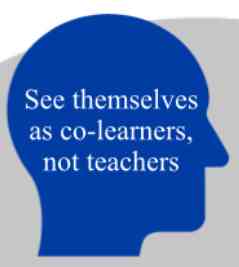
Proverbs 27:17 - "As iron sharpens iron, so one person sharpens another."
Modern teachers who see themselves as co-learners rather than traditional authority figures foster a more dynamic and interactive learning environment. This perspective shifts the focus from a one-way transmission of knowledge to a collaborative process where both teachers and students engage in the learning journey together. By positioning themselves as co-learners, teachers encourage a classroom culture where curiosity, exploration, and mutual respect are paramount. This approach aligns with Vygotsky's (1978) theory of social constructivism, which posits that learning is a socially mediated activity. In this model, teachers and students co-construct knowledge through dialogue, questioning, and collaborative problem-solving, making the learning experience richer and more meaningful for all participants.
Viewing teaching as a collaborative process also helps break down the traditional hierarchies that can inhibit student engagement and participation. When teachers acknowledge that they too are learning, they validate the experiences and insights that students bring to the classroom. This mutual exchange of ideas can lead to deeper understanding and innovation, as diverse perspectives are considered and integrated. Palmer (1998) emphasizes the importance of teachers being present and authentic in their interactions with students, arguing that this authenticity fosters a genuine community of learners. By embracing their role as co-learners, teachers not only enhance their own professional development but also empower students to take ownership of their learning, thereby creating a more inclusive and empowering educational environment.
3. Allow themselves to fail, often

James 1:2-4 - "Consider it pure joy, my brothers and sisters, whenever you face trials of many kinds, because you know that the testing of your faith produces perseverance. Let perseverance finish its work so that you may be mature and complete, not lacking anything."
Modern teachers who allow themselves to fail, often embrace failure as an integral part of the learning and growth process. This acceptance of failure serves as a powerful model for students, demonstrating that setbacks are not only inevitable but also valuable opportunities for development. By transparently sharing their own experiences of failure and how they overcame them, teachers can normalize the concept of failure, reducing the stigma and fear associated with it. This approach aligns with Dweck’s (2006) research on growth mindset, which emphasizes that viewing challenges and failures as opportunities to learn fosters resilience and persistence. When teachers openly navigate their own failures, they illustrate the process of problem-solving, reflection, and perseverance, providing students with a realistic and constructive framework for dealing with their own challenges.
Furthermore, by allowing themselves to fail, teachers create a classroom culture that encourages risk-taking and innovation. In such an environment, students feel more comfortable experimenting with new ideas and approaches without the paralyzing fear of making mistakes. This kind of supportive atmosphere is crucial for fostering creativity and critical thinking, skills that are essential for success in the 21st century. Research by Boaler (2016) highlights that students who are encouraged to struggle and fail in a supportive environment tend to develop deeper understanding and greater confidence in their abilities. When failure is seen as a natural and valuable part of the learning process, students are more likely to engage fully, take academic risks, and ultimately achieve higher levels of mastery and innovation. By modeling this mindset, teachers not only enhance their own teaching practices but also equip their students with essential life skills for continuous learning and adaptation.
4. Don't wait until they're experts to introduce something

Ecclesiastes 11:4 - "Whoever watches the wind will not plant; whoever looks at the clouds will not reap."
Modern educators understand the importance of being proactive and adventurous in their teaching methods, which includes introducing new ideas and technologies before mastering them completely. By doing so, they demonstrate a willingness to learn alongside their students, which fosters a collaborative and inclusive learning environment. This approach not only keeps the classroom dynamic and up-to-date with the latest advancements but also models a continuous learning mindset for students. It encourages a culture where both teachers and students are co-explorers, discovering and navigating new tools and concepts together. As Richardson (2015) suggests, embracing new technologies and methodologies without waiting for complete expertise encourages a more innovative and adaptive educational practice.
This approach also helps demystify the learning process, showing students that expertise is not a prerequisite for engagement. When teachers dive into new subjects or technologies with their students, they highlight the importance of curiosity and the learning journey itself over the end result. This can be particularly empowering for students, who might otherwise feel intimidated by new and complex topics. According to Mishra and Koehler (2006), teachers who integrate technology effectively are those who understand the interplay between technology, pedagogy, and content knowledge. By introducing new ideas and technologies as co-learners, teachers not only expand their own pedagogical toolkit but also prepare students to be flexible and resilient learners, capable of adapting to the ever-evolving landscape of knowledge and technology.
5. Move into their students' world, even if it's foreign territory

1 Corinthians 9:22 - "To the weak I became weak, to win the weak. I have become all things to all people so that by all possible means I might save some."
Modern teachers recognize the importance of stepping into their students' worlds to build meaningful connections and enhance the relevance of learning. By making an effort to understand and engage with their students' interests, experiences, and cultural backgrounds, teachers can create a more inclusive and supportive classroom environment. This approach aligns with culturally responsive teaching, which aims to make learning more relevant and effective for students by incorporating their cultural references in all aspects of learning (Gay, 2018). When teachers show genuine interest in the things that matter to their students, whether it be pop culture, social media trends, or personal hobbies, they not only validate their students' identities but also make the learning experience more engaging and relatable.
Furthermore, moving into their students' world helps bridge the gap between in-school learning and out-of-school experiences, making education more holistic. This practice can increase student motivation and participation, as they see their personal lives reflected and valued in the classroom. Ladson-Billings (1995) argues that teachers who incorporate students' cultural backgrounds and interests into their teaching practices promote higher levels of academic achievement and self-efficacy. By understanding and integrating these elements, teachers can design lessons that are more relevant and interesting, thus fostering a deeper connection with the material. This connection not only enhances students' academic engagement but also helps them develop a stronger sense of belonging and identity within the educational setting.
6. Run towards areas of weakness, not away from it

Philippians 4:13 - "I can do all this through him who gives me strength."
Modern teachers understand that personal and professional growth often comes from addressing their own areas of weakness head-on. Instead of shying away from their limitations, they actively seek opportunities to confront and overcome them. This proactive approach not only helps them become more effective educators but also sets a powerful example for their students. By willingly engaging with challenging subjects or skills, teachers demonstrate a commitment to lifelong learning and continuous self-improvement. This attitude resonates with the principles of reflective practice, as described by Schön (1983), which emphasizes the importance of self-awareness and critical reflection in professional development. When teachers model this behavior, they encourage their students to adopt a similar mindset, fostering a culture of resilience and perseverance.
Confronting weaknesses also allows teachers to diversify their teaching methods and better meet the needs of their students. For example, a teacher who struggles with integrating technology in the classroom might take professional development courses or collaborate with tech-savvy colleagues to improve their skills. This not only enhances their own competence but also enriches the learning experiences they provide to their students. Research by Hattie (2009) suggests that teachers' willingness to learn and adapt significantly impacts student achievement. By addressing their weaknesses, teachers can discover new strategies and tools that enhance their instructional practices, ultimately leading to more effective teaching and improved student outcomes. This commitment to self-improvement underscores the dynamic and evolving nature of modern education, where continuous growth is essential for both teachers and students.
7. Are comfortable not knowing what is going to happen
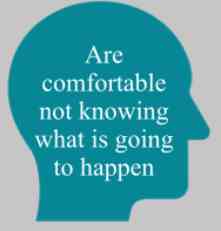
Matthew 6:34 - "Therefore do not worry about tomorrow, for tomorrow will worry about itself. Each day has enough trouble of its own."
Modern teachers are characterized by their adaptability and flexibility, which allows them to be comfortable with uncertainty and the unexpected aspects of the learning process. In an educational landscape that is constantly evolving, the ability to navigate ambiguity is crucial. Teachers who are comfortable with not knowing what is going to happen can more effectively respond to the diverse and ever-changing needs of their students. This quality aligns with the concept of adaptive expertise, which involves the ability to apply knowledge creatively and flexibly in different situations (Hatano & Inagaki, 1986). By embracing uncertainty, teachers model for their students how to approach new challenges with curiosity and openness, fostering a classroom environment that encourages experimentation and innovation.
Being comfortable with uncertainty also means that teachers can pivot quickly and effectively when plans do not go as expected. This flexibility is particularly important in today's classrooms, where unexpected events—such as technological failures, shifts in student dynamics, or sudden changes in curriculum—can occur frequently. According to Weick and Sutcliffe (2007), organizations (including schools) that cultivate a sense of mindfulness and an ability to adapt in the face of uncertainty are more resilient and better equipped to handle crises. For teachers, this means being able to maintain a positive and productive learning environment even when faced with unforeseen challenges. By demonstrating calm and adaptability, teachers help students learn how to manage their own responses to uncertainty, equipping them with valuable life skills for navigating a complex and unpredictable world.
8. Invite mistakes into their lives
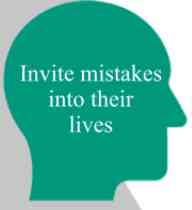
Proverbs 24:16 - "For though the righteous fall seven times, they rise again, but the wicked stumble when calamity strikes."
Modern teachers actively invite mistakes into their lives, fostering a classroom culture where errors are viewed not as failures but as valuable learning opportunities. By normalizing mistakes, they create an environment where students feel safe to take risks and explore new ideas without the fear of being judged. This approach aligns with the concept of "productive failure," introduced by Kapur and Bielaczyc (2012), which suggests that encountering and struggling with problems before receiving direct instruction leads to deeper understanding and retention of knowledge. When teachers model this mindset, they help students develop resilience and a growth mindset, encouraging them to see mistakes as a natural and essential part of the learning process rather than something to be avoided.
Creating a culture that embraces mistakes also enhances critical thinking and problem-solving skills among students. When errors are openly discussed and analyzed, students learn to approach problems from multiple angles and develop more robust strategies for overcoming challenges. This reflective practice not only improves their academic performance but also prepares them for real-world situations where the ability to learn from failure is crucial. According to Brookhart (2010), formative assessment practices that include constructive feedback on mistakes can significantly improve student learning outcomes. By inviting mistakes into their lives and encouraging students to learn from them, teachers cultivate a classroom environment that promotes continuous improvement, innovation, and a lifelong love of learning.
9. Dream big and ask "Why not?"

Ephesians 3:20 - "Now to him who is able to do immeasurably more than all we ask or imagine, according to his power that is at work within us."
Modern teachers are ambitious and visionary, inspiring their students to think creatively and ambitiously. They cultivate an environment where dreaming big is not only encouraged but expected. By posing the question "Why not?", teachers challenge both themselves and their students to push boundaries and explore possibilities that might initially seem out of reach. This approach fosters a growth mindset, where students learn to view challenges as opportunities for growth rather than insurmountable obstacles. Such an attitude helps students to develop resilience, critical thinking, and a proactive approach to learning and problem-solving (Dweck, 2006). By encouraging students to envision bold goals and pursue them with confidence, teachers create a classroom culture that values innovation and perseverance.
In this rapidly evolving educational landscape, teachers who dream big and encourage their students to ask "Why not?" play a pivotal role in preparing the next generation for future challenges. They move beyond traditional teaching methods, embracing innovative and experiential learning opportunities that stimulate curiosity and creativity. These educators understand that the world is continuously changing and that preparing students for the future involves equipping them with the skills and mindset necessary to navigate and shape that change. By embodying a visionary and ambitious spirit, modern teachers inspire students to imagine new possibilities and to strive towards achieving them, thus fostering a culture of innovation and excellence in education (Robinson, 2011). This visionary approach not only benefits individual students but also contributes to the broader goal of advancing society through education.
10. Allow their students to teach each other

Romans 12:4-5 - "For just as each of us has one body with many members, and these members do not all have the same function, so in Christ we, though many, form one body, and each member belongs to all the others."
Modern teachers actively promote peer learning, recognizing the immense value of students teaching and learning from one another. This approach, known as peer-assisted learning (PAL), leverages the social and collaborative aspects of education, allowing students to engage more deeply with the material by explaining concepts to their peers. By facilitating peer teaching, educators create a dynamic and interactive learning environment where students are encouraged to articulate their understanding, ask questions, and engage in critical thinking. This method not only reinforces the students' own knowledge but also enhances their communication and leadership skills (Topping, 2005).
Moreover, peer learning fosters a sense of community and shared responsibility within the classroom. Students often feel more comfortable and less intimidated when learning from their peers, which can lead to increased participation and engagement. Teachers who embrace this strategy understand that learning is a social process and that students can offer diverse perspectives and insights that enrich the educational experience. By allowing students to teach each other, modern educators cultivate an inclusive and supportive learning environment where every student has the opportunity to contribute and grow. This approach aligns with contemporary educational theories that emphasize the importance of collaborative and active learning (Vygotsky, 1978).
11. Step outside their comfort zone

Joshua 1:9 - "Have I not commanded you? Be strong and courageous. Do not be afraid; do not be discouraged, for the Lord your God will be with you wherever you go."
Modern teachers continuously challenge themselves to step outside their comfort zones, embracing new approaches and methods to create a dynamic and engaging learning environment. This willingness to explore uncharted territory reflects a commitment to lifelong learning and professional growth. By experimenting with innovative teaching strategies, incorporating technology, and adopting diverse pedagogical techniques, educators can better meet the varied needs of their students. This adaptive approach not only enhances student engagement but also prepares them to navigate an ever-changing world. As Fullan and Langworthy (2014) highlight, the role of teachers is evolving to include being facilitators of deep learning experiences, which requires a readiness to adopt new practices and continuously reflect on their effectiveness.
Stepping outside their comfort zones also means that teachers model the very behaviors they wish to instill in their students: resilience, adaptability, and a growth mindset. When educators take risks and try new methods, they demonstrate that failure and mistakes are natural parts of the learning process. This can foster a classroom culture where students feel safe to take intellectual risks and embrace challenges. According to Hargreaves and Fullan (2012), this approach not only benefits individual students but also contributes to a more vibrant and innovative school community. By continually pushing their boundaries, modern teachers ensure that their instructional methods remain relevant, effective, and inspiring.
12. Embrace change
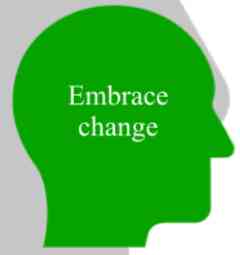
Isaiah 43:19 - "See, I am doing a new thing! Now it springs up; do you not perceive it? I am making a way in the wilderness and streams in the wasteland."
Modern teachers are distinguished by their openness to change and innovation, continuously evolving their teaching practices to meet new challenges. In a rapidly shifting educational landscape, they recognize that clinging to traditional methods can hinder progress and student engagement. By embracing change, teachers stay abreast of the latest educational research, technological advancements, and pedagogical strategies. This proactive approach enables them to integrate new tools and techniques that enhance learning outcomes and make education more relevant and exciting for their students. According to Darling-Hammond et al. (2020), effective educators are those who are not only receptive to change but also actively seek out opportunities for professional development and growth.
Moreover, embracing change involves a willingness to experiment and take risks in the classroom. Modern teachers understand that innovation often comes with a degree of uncertainty and potential for failure, but they view these as opportunities for learning and improvement. This mindset fosters a resilient and adaptable learning environment where students are encouraged to think critically and creatively. As highlighted by Fullan (2016), embracing change is essential for fostering a culture of continuous improvement and adaptability within schools. By modeling this attitude, teachers inspire their students to be flexible and open-minded, skills that are crucial for success in an ever-evolving world.
13. Feel secure asking their colleagues for help
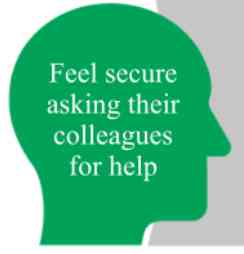
Galatians 6:2 - "Carry each other’s burdens, and in this way you will fulfill the law of Christ."
Modern teachers are collaborative by nature and understand the importance of seeking support and advice from their peers. They recognize that teaching is a complex and demanding profession that benefits greatly from the collective expertise and experiences of a community of educators. By feeling secure in asking their colleagues for help, they promote a culture of mutual respect and collective growth within their schools. This collaborative approach not only enhances their own professional development but also leads to improved outcomes for students. According to Hargreaves and O'Connor (2018), collaborative professionalism involves deep and purposeful professional relationships where teachers work together to solve problems, share practices, and innovate.
Furthermore, when teachers feel comfortable seeking assistance from their colleagues, it fosters an environment of trust and openness. This supportive atmosphere encourages the sharing of resources, strategies, and constructive feedback, which can lead to more effective teaching practices. Collaboration among teachers also facilitates the identification and implementation of best practices, helping to create a more consistent and high-quality educational experience for all students. As Wenger (1998) notes in his work on communities of practice, such collaborative environments enable educators to build a shared repertoire of resources and approaches that can be continually refined and improved upon. By valuing and seeking out peer support, modern teachers exemplify the principles of continuous learning and professional solidarity.
14. Model resiliency and perseverance

Hebrews 12:1 - "Therefore, since we are surrounded by such a great cloud of witnesses, let us throw off everything that hinders and the sin that so easily entangles. And let us run with perseverance the race marked out for us."
Modern teachers demonstrate resiliency and perseverance, embodying persistence and determination in their professional practices and interactions with students. By modeling these traits, they serve as powerful role models, showing students the importance of overcoming obstacles and persisting through challenges. This is particularly crucial in today's fast-paced and often unpredictable world, where adaptability and resilience are essential skills. Teachers who consistently exhibit resilience can inspire their students to adopt a similar mindset, encouraging them to approach difficulties with a problem-solving attitude and a sense of optimism. As Duckworth (2016) points out in her research on grit, perseverance combined with passion is a key predictor of success in various life domains, including education.
Furthermore, modeling resiliency and perseverance involves more than just displaying a positive attitude. It includes sharing personal experiences of failure and success, demonstrating coping strategies, and providing a supportive environment where students feel safe to take risks and make mistakes. Teachers who openly discuss their own struggles and how they overcame them help to demystify the process of learning and growth, making it clear that failure is a natural part of achieving success. This approach aligns with Dweck's (2006) concept of a growth mindset, which emphasizes the belief that abilities and intelligence can be developed through dedication and hard work. By embodying resilience and perseverance, teachers not only enhance their own teaching efficacy but also foster a classroom culture that values effort, persistence, and continuous improvement.
15. Question everything

1 Thessalonians 5:21 - "But test them all; hold on to what is good."
Modern teachers embody the principle of questioning everything, fostering an environment where critical thinking and curiosity are paramount. They encourage their students to constantly question assumptions, norms, and the status quo, promoting a culture of intellectual inquiry and skepticism. This approach helps students develop a deeper understanding of the world around them, as they learn to analyze information critically, identify biases, and make informed decisions. According to Paul and Elder (2008), critical thinking is essential for effective problem-solving and decision-making, and it involves the ability to think clearly and rationally about what to believe or what to do. By instilling these skills, teachers prepare students to navigate complex issues and challenges both within and beyond the classroom.
Moreover, questioning everything aligns with the Socratic method of teaching, which emphasizes dialogue and critical questioning as a means of exploring ideas and uncovering underlying assumptions. Modern educators who adopt this method create a dynamic and interactive learning environment where students are active participants in their own education. They pose thought-provoking questions that challenge students to think deeply and articulate their reasoning. This not only enhances students' cognitive abilities but also fosters a sense of intellectual curiosity and a lifelong love of learning. As Brookfield (2012) notes, questioning assumptions is a fundamental aspect of transformative learning, which leads to profound changes in how individuals perceive and interact with the world. By modeling and encouraging this approach, modern teachers help students become more reflective, analytical, and open-minded.
16. Believe they can learn anything, given the right attitude and effort

Philippians 4:13 - "I can do all this through him who gives me strength."
Modern teachers embody a growth mindset, believing that with the right attitude and effort, they and their students can learn and achieve anything. This perspective, rooted in Carol Dweck's research, emphasizes that abilities and intelligence are not fixed traits but can be developed through dedication and hard work (Dweck, 2006). By fostering this belief, teachers encourage students to embrace challenges, persist in the face of setbacks, and see effort as the path to mastery. This mindset not only enhances students' academic performance but also builds resilience and a lifelong love of learning. Teachers with a growth mindset model this attitude by continually seeking professional development opportunities and remaining open to new teaching strategies and technologies.
Moreover, the belief that effort and attitude determine success creates a positive and empowering classroom environment. Students who are taught to adopt a growth mindset understand that their abilities can be developed, which leads to increased motivation and engagement. These students are more likely to take on difficult tasks, seek feedback, and persist until they achieve their goals. Teachers play a crucial role in cultivating this mindset by providing constructive feedback, celebrating effort and progress, and framing mistakes as valuable learning opportunities. As Blackwell, Trzesniewski, and Dweck (2007) found, students who are encouraged to develop a growth mindset show greater academic improvement and resilience. By instilling this belief, modern teachers help students build the confidence and perseverance needed to succeed in an ever-changing world.
Conclusion
The profile of a modern teacher is reflected in various Scripture passages that emphasize qualities such as humility, perseverance, adaptability, and collaboration. For example, teachers choose to be vulnerable, as seen in 2 Corinthians 12:9, and see themselves as co-learners, not just teachers, as highlighted in Proverbs 27:17. They allow themselves to fail often (James 1:2-4) and do not wait until they're experts to introduce new concepts (Ecclesiastes 11:4). They engage deeply with their students' world (1 Corinthians 9:22), confront their weaknesses (Philippians 4:13), and are comfortable with uncertainty (Matthew 6:34). Modern teachers invite mistakes (Proverbs 24:16), dream big (Ephesians 3:20), encourage peer teaching (Romans 12:4-5), and step outside their comfort zones (Joshua 1:9). They embrace change (Isaiah 43:19), feel secure asking for help (Galatians 6:2), model resilience (Hebrews 12:1), question everything (1 Thessalonians 5:21), and believe in their ability to learn anything with the right attitude (Philippians 4:13). These passages align with the mindset and behaviors of modern educators, promoting an environment conducive to growth and learning.
In conclusion, the profile of a modern teacher encompasses a transformative approach to education that prioritizes adaptability, collaboration, and continuous growth. By embracing vulnerability, viewing themselves as co-learners, and welcoming failure as part of the learning journey, these educators create environments where students feel safe to explore, question, and innovate. They actively engage with new ideas and technologies, step into their students' worlds, and confront weaknesses head-on, all while fostering a culture of resilience and curiosity. Through their commitment to embracing change, promoting peer learning, and cultivating a growth mindset, modern teachers inspire both students and colleagues alike to dream big and challenge the status quo in pursuit of meaningful learning experiences.
The essence of a modern teacher lies in their willingness to evolve and adapt to the ever-changing landscape of education. By embodying traits such as vulnerability, resilience, and a relentless pursuit of learning, they not only empower their students but also redefine the role of education in the 21st century. These educators exemplify how embracing uncertainty and embracing failure can lead to profound growth and innovation, ultimately shaping a generation of learners who are not only prepared to succeed but also equipped to thrive in an increasingly complex world.
References:
Blackwell, L. S., Trzesniewski, K. H., & Dweck, C. S. (2007). Implicit theories of intelligence predict achievement across an adolescent transition: A longitudinal study and an intervention. Child Development, 78(1), 246-263.
Boaler, J. (2016). Mathematical mindsets: Unleashing students' potential through creative math, inspiring messages and innovative teaching. Jossey-Bass.
Brookfield, S. D. (2012). Teaching for critical thinking: Tools and techniques to help students question their assumptions. Jossey-Bass.
Brookhart, S. M. (2010). Formative assessment strategies for every classroom: An ASCD action tool (2nd ed.). ASCD.
Brown, B. (2012). Daring greatly: How the courage to be vulnerable transforms the way we live, love, parent, and lead. Gotham Books.
Darling-Hammond, L., Hyler, M. E., & Gardner, M. (2020). Effective teacher professional development. Learning Policy Institute.
Duckworth, A. (2016). Grit: The power of passion and perseverance. Scribner.
Fullan, M. (2016). The new meaning of educational change (5th ed.). Teachers College Press.
Fullan, M., & Langworthy, M. (2014). A rich seam: How new pedagogies find deep learning. Pearson.
Gay, G. (2018). Culturally responsive teaching: Theory, research, and practice (3rd ed.). Teachers College Press.
Hargreaves, A., & Fullan, M. (2012). Professional capital: Transforming teaching in every school. Teachers College Press.
Hatano, G., & Inagaki, K. (1986). Two courses of expertise. In H. A. H. Stevenson, & K. Hakuta (Eds.), Child development and education in Japan (pp. 262-272). Freeman.
Hattie, J. (2009). Visible learning: A synthesis of over 800 meta-analyses relating to achievement. Routledge.
Kapur, M., & Bielaczyc, K. (2012). Designing for productive failure. Journal of the Learning Sciences, 21(1), 45-83.
Ladson-Billings, G. (1995). Toward a theory of culturally relevant pedagogy. American Educational Research Journal, 32(3), 465-491.
Mishra, P., & Koehler, M. J. (2006). Technological pedagogical content knowledge: A framework for teacher knowledge. Teachers College Record, 108(6), 1017-1054.
Palmer, P. J. (1998). The courage to teach: Exploring the inner landscape of a teacher's life. Jossey-Bass.
Paul, R., & Elder, L. (2008). The miniature guide to critical thinking: Concepts and tools. Foundation for Critical Thinking Press.
Richardson, W. (2015). From master teacher to master learner. Solution Tree Press.
Robinson, K. (2011). Out of our minds: Learning to be creative. Capstone Publishing.
Schön, D. A. (1983). The reflective practitioner: How professionals think in action. Basic Books.
Topping, K. J. (2005). Trends in peer learning. Educational Psychology, 25(6), 631-645.
Vygotsky, L. S. (1978). Mind in society: The development of higher psychological processes. Harvard University Press.
Weick, K. E., & Sutcliffe, K. M. (2007). Managing the unexpected: Resilient performance in an age of uncertainty (2nd ed.). Jossey-Bass.
Wenger, E. (1998). Communities of practice: Learning, meaning, and identity. Cambridge University Press.
Baca konten-konten menarik Kompasiana langsung dari smartphone kamu. Follow channel WhatsApp Kompasiana sekarang di sini: https://whatsapp.com/channel/0029VaYjYaL4Spk7WflFYJ2H






















